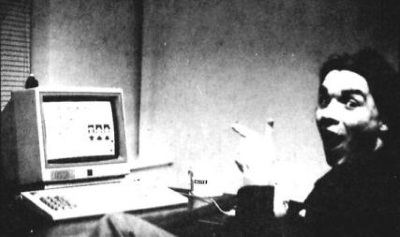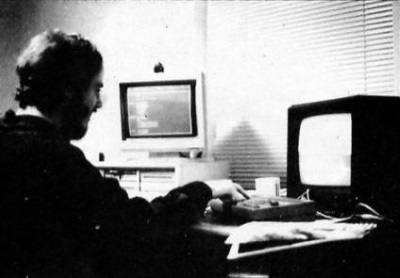
Programmer Fred Williams at work using the PDS link between a PC and a +2

Programmer Fred Williams at work using the PDS link between a PC and a +2
Barely a month goes by without CRASH receiving a letter that goes ‘I want to be a programmer, how do you do it? I enclose a stamped addressed envelope.’ Where do you start to explain the ins and outs? Erm... Well, we haven’t a clue. But we know a man who does! Here Paul Ranson, boss of development house The Big Red Software Company, creators of Wacky Darts, Dizzy 4 and CRASH’s Dizzy 3.5, reveals the basics...
‘How do you write computer games? It’s a question that’s often asked but not easily answered. Computer games programming has come a long way since the days when a couple of mates tapping away on a rubber-keyed Spectrum with a copy of Machine Code Programming for the Absolute Beginner, Art Studio and three pages of game specification could knock out a chart-topping success. Nowadays, you rarely find publishers giving contracts to bedroom hackers.
Work is invariably given to development houses, many employing up to 20 programmers, artists and musicians. Creating computer games is now a highly specialised job. Good games are a combination of the talents of artists, musicians and programmers. The work is hard and full of high pressure: often programmers will have to work through the night to complete projects in time.
So what is required to become a computer games programmer? Well, you require three talents: a skill in solving logical problems, a thorough grounding in maths, and an appreciation of what looks good. Then, of course, you need a good dollop of experience.
A good programmer is not worth a sausage without a development kit to match. Virtually no computer games are developed using a single Spectrum. Instead, the Spectrum is controlled by a host computer, in our case an IBM PC. A special gadget is plugged into the expansion port of the Spectrum which connects it to the back of the IBM. This circuitry, known as a transfer board, allows the Spectrum and IBM to communicate. The program instructions are typed into the IBM and with the press of a button (in Big Red’s case, the ‘Y’ key) the program is transported from the IBM into the Spectrum.
The advantage of using equipment like this is twofold. It allows programmers to dedicate more memory to the game which, in turn, means more graphics, more gameplay and more music. Also, the games are programmed much quicker which, due to publishers’ deadlines, gives programmers time to improve their games’ presentation.
So, how much does all this gadgetry cost? The answer is: a bloomin’ packet! A decent IBM retails at approximately £1,000, the transfer board another £500. For the Spectrum and television, add another £300. With a desk, chair, tape deck and coffee mug, there’s not much change left from £2,000 by the time you’ve finished.

Peter Ranson, one of Big Red’s graphic artists, using an IBM to create a few Dizzy graphics
Graphics, on the other hand, are comparatively cheaper to produce. The industry standard art package is Electronic Arts’ Deluxe Paint running on an Amiga or, preferably, an IBM PC. Graphics are drawn in a Spectrum monochrome mode and then transported, using the transfer board, onto the Spectrum where attributes are added with Art Studio. Generally, all the main game sprites and pictures are drawn this way. A good loading screen, however, is drawn exclusively with Art Studio.
With all the art students there are in the world, you would’ve thought a good computer artist is quite easy to find. Not so. To simply be able to sketch is not enough. Using a mouse is worlds away from drawing with a pencil; try writing your name with one! Artists must be able to animate sprites, squeeze them into specific sized boxes and, in the case of Spectrum loading screens, use attributes! All very clever stuff.
Technically, the computer musician has the most difficult job. He uses a strange combination of artistic and technical skill, the artistic to create the tunes, sometimes as many as two or three a month, and the technical to write his music driver, which should be as fast as any of the programmers’ sprite routines, or it slows the game down.
Each musician has a different way of composing. Generally it’s done using some nifty sequencing software running on the Amiga or Atari ST to create a three-track music score. This is then reduced to its individual notes and included in the Spectrum’s music driver. Later this is given to the programmer who adds it into the game.
The time it takes to develop a game varies depending upon the technical difficulties. Usually projects are completed between 12 and 20 weeks.
Creating games on the Spectrum is great fun. Obviously, it’s nine-year-old technology is beginning to show its age but the latest games show that the Spectrum can give consoles a run for their money. With a user base of over five and a half million computers, publishers won’t ignore the Spectrum for a long time to come. Indeed, with some of the quality games being produced by Ocean, Virgin, Mirrorsoft, Gremlin and Code Masters they seem to be doing it in style!
Programming, designing and creating a smash hit is not an easy job, though as Paul points out it can be fun and rewarding. If you want to know more about games design and programming, drop us a line. Tell us what questions you’d like answering; how much memory sound should take up, for example. Or if you’d like to see a whole feature on some other area of games development, just send in your idea and we’ll put Paul on the case.